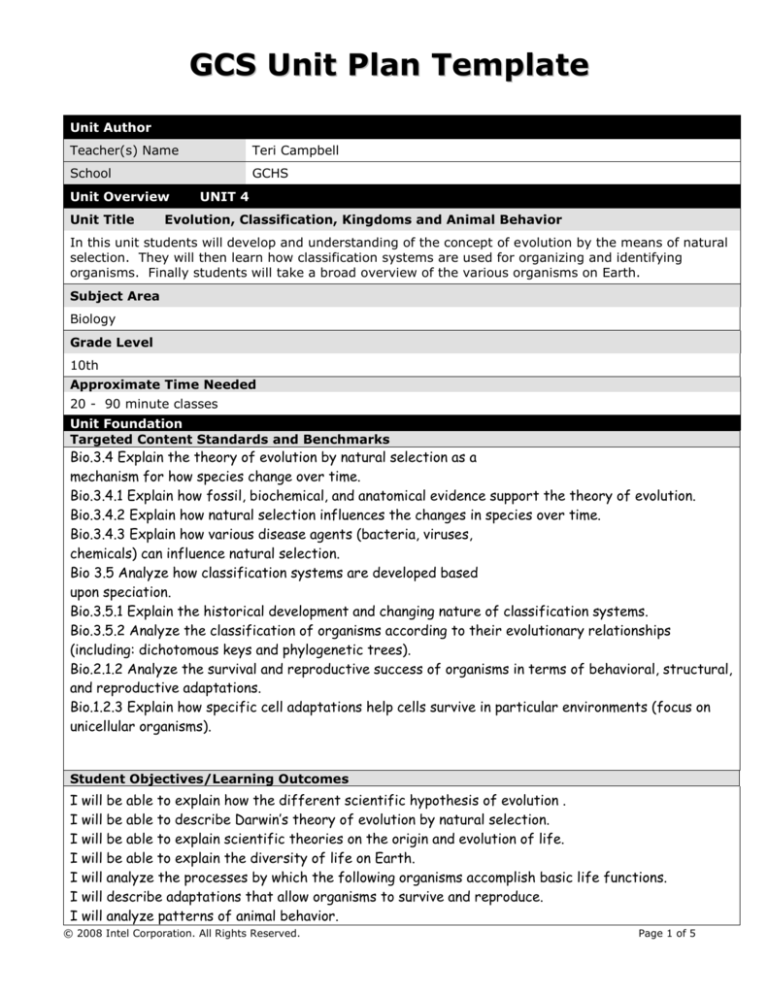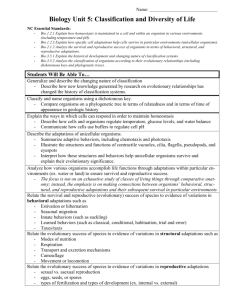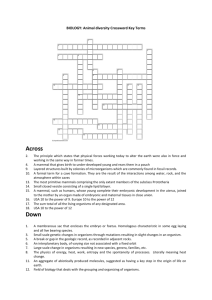
GCS Unit Plan Template
Unit Author
Teacher(s) Name
Teri Campbell
School
GCHS
Unit Overview
Unit Title
UNIT 4
Evolution, Classification, Kingdoms and Animal Behavior
In this unit students will develop and understanding of the concept of evolution by the means of natural
selection. They will then learn how classification systems are used for organizing and identifying
organisms. Finally students will take a broad overview of the various organisms on Earth.
Subject Area
Biology
Grade Level
10th
Approximate Time Needed
20 - 90 minute classes
Unit Foundation
Targeted Content Standards and Benchmarks
Bio.3.4 Explain the theory of evolution by natural selection as a
mechanism for how species change over time.
Bio.3.4.1 Explain how fossil, biochemical, and anatomical evidence support the theory of evolution.
Bio.3.4.2 Explain how natural selection influences the changes in species over time.
Bio.3.4.3 Explain how various disease agents (bacteria, viruses,
chemicals) can influence natural selection.
Bio 3.5 Analyze how classification systems are developed based
upon speciation.
Bio.3.5.1 Explain the historical development and changing nature of classification systems.
Bio.3.5.2 Analyze the classification of organisms according to their evolutionary relationships
(including: dichotomous keys and phylogenetic trees).
Bio.2.1.2 Analyze the survival and reproductive success of organisms in terms of behavioral, structural,
and reproductive adaptations.
Bio.1.2.3 Explain how specific cell adaptations help cells survive in particular environments (focus on
unicellular organisms).
Student Objectives/Learning Outcomes
I will be able to explain how the different scientific hypothesis of evolution .
I will be able to describe Darwin’s theory of evolution by natural selection.
I will be able to explain scientific theories on the origin and evolution of life.
I will be able to explain the diversity of life on Earth.
I will analyze the processes by which the following organisms accomplish basic life functions.
I will describe adaptations that allow organisms to survive and reproduce.
I will analyze patterns of animal behavior.
© 2008 Intel Corporation. All Rights Reserved.
Page 1 of 5
Cross-Curricular Connections
Math – Hardy-Weinberg calculations for honors students
Health Sciences – project on genetic disorders
Curriculum-Framing Questions
Essential
Question
Unit
Questions
How do the different scientific theories of evolution explain the diversity of
life on Earth?
How and why do different structures found in very different organisms (such
as plant vs. animals) perform similar functions?
How do populations change over time?
How do new species evolve?
What makes allele frequency an important concept in biological evolution?
How do Biologists organize and classify life?
How can the Hardy-Weinberg Principle be applied to actual populations?
What types of evolutionary adaptations, found in different divisions of life,
have increased efficiency and survival or organisms?
What are some patterns of behavior that relate to humans?
What is a species?
How does a species differ from a population?
Content
Questions
What is a cladogram?
What is a phylogenetic tree?
Assessment Plan
Assessment Summary
Quizzes, Tests, class work, homework, labs
Unit Details
Prerequisite Skills
Students should have a basic understanding of the age of the Earth and geologic timeline. They should
also understand how fossils form and what information can be gleaned from fossils. Both of these were
a part of their Earth Science curriculum.
Instructional Procedures
Days 1 & 2
Student guided review of the age of the Earth.
Discussion of fossils and the use of relative and radioactive dating of artifacts.
Half life activity using Skittles. Students collect data, draw a graph and compare it to the graphs of
other students.
Discuss Oparin’s Hypothesis and the Miller and Urey experiment. Show a 5 minute clip from the Carl
Sagan video
Days 3 & 4
© 2008 Intel Corporation. All Rights Reserved.
Page 2 of 5
Discussion of Charles Darwin and his journey. Video on the Life of Darwin.
Evidences Darwin saw while on his trip that helped him developed his theory of evolution by means of
natural selection. Focus on finches and tortoises.
Ideas of LaMarck
Methods of Speciation
Changing the gene pool of a population
Hardy-Weinberg Principle calculations (Arms and Camp book) Honors only
Days 5 & 6
Study of classification.
-history
-modern techniques used in classification
-binomial nomenclature
-Domains, Kingdom, Phylum, Class, Order, Family, Genus, Species
-cladistics and phylogenetics trees
-use of dichotomous keys in classification
-creation of dichotomous keys for classification
Days 7-15
Students will be taken on an overview of organisms
It will begin with the non-living particles, viruses.
We will then progress to baceria.
http://video.pbs.org/video/2365104403/
Frontline segment on super bacteria
Bacteria – types, methods of reproduction, classification, how they can be harmful and helpful
Protist- types, methods of reproduction, classification, how they can be helpful and harmful
http://www.biology-resources.com/biology-videos-protista.html
view specimens from Carolina and pond water
Fungi – types, methods of reproduction, classification, how they can be helpful and harmful(WebQuest)
http://www.bbc.co.uk/nature/life/Fungus#p00lx5jh
Possible mushroom dissection and spore print formation in addition to consuming some mushrooms
Animals – brief look at invertebrate groups and basic information regarding reproduction, movement of
materials, digestion, excretion
Life on Earth video clips
Discussion of vertebrates – Fish, Amphibians, Reptiles, Birds Mammals with a concentration on the basic
information regarding reproduction, movement of materials, digestion, excretion
Days 16 – 17
Students will learn about innate and learned behaviors. Emphasis will be placed on how the following
behaviors affect the survival of organisms: instinct, habituation, classical conditioning, operant
conditioning, insight, imprinting, and methods of communication.
Big Bang video clip on Operant Conditioning - http://www.youtube.com/watch?v=Mt4N9GSBoMI
Classical Conditioning Video clip - http://www.youtube.com/watch?v=6pNzq9v8Pu0
http://www.youtube.com/watch?v=W0vLy41Hubw
© 2008 Intel Corporation. All Rights Reserved.
Page 3 of 5
Imprinting video
http://www.pbs.org/wnet/nature/episodes/my-life-as-a-turkey/full-episode/7378/
Day 18
Review for Unit Test
Day 19
Unit Test
Accommodations for Differentiated Instruction
Special Needs
Students
Students will use a variety of manipulatives (picture arrangement to
classify organisms)
Gifted/Talented
Students
Students will be encouraged to make evolutionary connections between
organisms and create phylogenetic trees for organisms as opposed to just
reading them.
Materials and Resources Required For Unit
Technology – Hardware (Click boxes of all equipment needed)
X Interactive Technology
X Computer(s)/iPads, etc.
Student Response
System/Clickers
Printer
Digital Camera
X Projection System
X DVD Player
Scanner
X Internet
Cell Phone
Video Camera
Video Conferencing Equip.
Document Camera
Other
X Television
Technology – Software (Click boxes of all software needed.)
Database/Spreadsheet
Image Processing
Web Page Development
Desktop Publishing
Internet Web Browser
Word Processing
E-mail
Multimedia
Other
X Web-Based Encyclopedia
Printed Materials
Supplies
Textbook, worksheets related to topics,
Examples of fungi, invertebrates, vertebrates for students to view
Frogs for dissection and dissection kits
© 2008 Intel Corporation. All Rights Reserved.
Page 4 of 5
Unit Plan Reflection
Describe any adaptations or “tweaks” to the resource or lesson plan that were needed:
What do you plan to do differently the next time you teach this unit?:
The time allowed for this unit was appropriate. Students really enjoyed the video clip on the transmission of
super bacteria.
By this time we a conducting fewer labs because of time and resources. I am going to search for two additional
labs to add to this unit to increase student involvement.
Page 5 of 5








